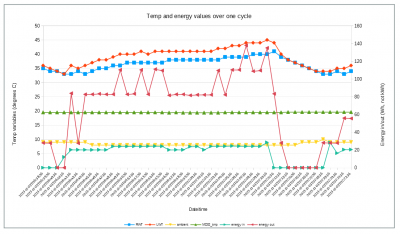I've just read the Grant link above ("Blog | How to control your heat pump") and it seems the terminology is somewhat confused as to what a setback is. For some of us, a setback (specifically a setback of the desired room temp on the room stat, say setting it back from 20 degrees to 12 degrees C) is in effect an on/off timer (because the house never cools to 12 degrees, and so the heat pump is off throughout the entire setback). For Grant, a setback appears to mean a setback in the LWT, ie the heat pump runs throughout, but with a lower LWT during the setback. To quote:
Understanding ‘Setback’
An important part of controlling a heat pump system is understanding the term ‘setback’. Heat pumps should not be completely turned off. This is because it can be costly to try and reach the desired temperature after it has dropped considerably as a result of the heat pump unit being switch off. ‘Setback’ control operation should be used instead which allow the heat pump to keeping running. This involves the system being in ‘energised’ mode during the hours when you are at home, running at the required higher flow temperature, and then it operates in ‘setback’ mode, setting to a lower flow temperature during the night and when you are away from the home. Using this cycle of ‘energised’ and ‘setback’ temperatures, the heat pump can operate very efficiently and can effectively keep the home warm.
This is followed by a less than helpful traffic light bar chart...
I am still unsure of the evidence for the amount of extra energy used during recovery from a setback. As I pointed our recently, cycling is a form of setback and recovery used by the heat pump to reduce it's output when it can't do that any other way, albeit over minutes rather than hours, but it is still a setback, and I can't see the extra energy used during the recovery. Here again is the quick and dirty plot I did of a recent cycle showing minute by minute energy in and out along with various temps:
The energy in ramps up over a couple of minutes, and then stays pretty much in a steady until it get turned off again.
Midea 14kW (for now...) ASHP heating both building and DHW
All depends on the house, i timed my unit to go off at 9pm last night, house was still 21 degrees this morning. Heating due to come back on at 2pm. I don't understand this extra energy required in my case. Currently have fixed flow @30deg to run for the 7hours. If i was to run constantly there is no way it could possibly be cheaper then running for the 7hours. Colder weather will tell more but if you can bear the morning being maybe 2-3deg colder then ambient in colder weather i think setback is a winner in some scenarios. For the 7hours yesterday including dhw legionella cycle i used 15kwh. That keeps house warm for 24hours then in these current conditions. Anytime i ran on wc i also had similar energy usage per hour but did encounter alot of cycling @lwt 27deg/28.
In my opinion 'cycling' is not the same as 'setback'. A heat pump cycles to prevent the IAT from increasing too high, whereas a setback is used to deliberately lower the IAT.
As you state, a large setback can be used as a means of stopping and starting a heat pump, without any degree of room temperature control. Conversely, a small setback can be used as a means of lowering room temperature in a controlled manner.
It is up to the individual to decide how low they are willing to allow the IAT to fall.
Posted by: @newhouse87All depends on the house, i timed my unit to go off at 9pm last night, house was still 21 degrees this morning. Heating due to come back on at 2pm. I don't understand this extra energy required in my case. Currently have fixed flow @30deg to run for the 7hours. If i was to run constantly there is no way it could possibly be cheaper then running for the 7hours. Colder weather will tell more but if you can bear the morning being maybe 2-3deg colder then ambient in colder weather i think setback is a winner in some scenarios. For the 7hours yesterday including dhw legionella cycle i used 15kwh. That keeps house warm for 24hours then in these current conditions. Anytime i ran on wc i also had similar energy usage per hour but did encounter alot of cycling @lwt 27deg/28.
How high does the IAT go during the heating period?
It would appear that you have a well insulated home, that probably has a large thermal mass, so your method of operation works fine in the present weather conditions. You may find that you have to extend the running period, or use controlled setback to prevent the IAT from falling too low.
Posted by: @derek-mIn my opinion 'cycling' is not the same as 'setback'. A heat pump cycles to prevent the IAT from increasing too high, whereas a setback is used to deliberately lower the IAT.
I think this is an interesting question. In both cases, the intention is to lower output, though the reasons are slightly - but are they materially? - different. Cycling happens because it is the only option left as a way to lower output when the heat needs to produce less than it does at minimum tick over. Setback on the other hand is voluntary, we choose to implement it, but the aim is the same, to lower output (which, we hope, will lower input, and in due course our bills). They are, I suggest, the same in all but name.
I think the more important clarification is whether a setback means on/off running (eg 18 hours on/6 hours off), however the on/off is achieved, and one way to achieve it is to set back the thermostat by a large amount for the off period, or the Grant version of a setback, which has the system running 23/7, with the LWT lowered during the setback. Both these options are called setbacks, but they are not the same, insofar as one has the heat pump stop, the other has it lower its output, but it is still running.
It seems to me the Grant option might well trigger short term ie minutes not hours cycling, ie heat pump imposed setbacks on top of the human selected setback. Oh what a tangled web we weave! A setback of a setback! However what the two options do have in common is that when moving from setback to normal operation, some sort of recovery is needed, because at the moment of the change over the house is not in steady state, it has been losing heat at a greater rate than it was replaced, and has cooled, and now it needs to have heat added faster than it is lost, to recover the desired non-setback room temperature.
Midea 14kW (for now...) ASHP heating both building and DHW
The kitchen gets to 23, all tiled floor and other living areas 22, while bedroom's 21. I actually lowered flow temp to 29 for today and i will check usage and temps when my workshift ends tonight. Yes i wont really know how my experiment plays out uintil we have freezing weather. as you said i will probably have to run longer but some homes may be a case of fixed flow temps being more optimal with overnight essentially off as house does not lose much heat. Even in cold weather if my usage doubled it would still be way lower then last winter when somedays 70kwh or more were used operating zonal with installer wc curve. Opening the house up as 1 zone as suggested by you and others i feel will make difference compared to then.Posted by: @derek-mPosted by: @newhouse87All depends on the house, i timed my unit to go off at 9pm last night, house was still 21 degrees this morning. Heating due to come back on at 2pm. I don't understand this extra energy required in my case. Currently have fixed flow @30deg to run for the 7hours. If i was to run constantly there is no way it could possibly be cheaper then running for the 7hours. Colder weather will tell more but if you can bear the morning being maybe 2-3deg colder then ambient in colder weather i think setback is a winner in some scenarios. For the 7hours yesterday including dhw legionella cycle i used 15kwh. That keeps house warm for 24hours then in these current conditions. Anytime i ran on wc i also had similar energy usage per hour but did encounter alot of cycling @lwt 27deg/28.
How high does the IAT go during the heating period?
It would appear that you have a well insulated home, that probably has a large thermal mass, so your method of operation works fine in the present weather conditions. You may find that you have to extend the running period, or use controlled setback to prevent the IAT from falling too low.
Posted by: @cathoderayPosted by: @derek-mIn my opinion 'cycling' is not the same as 'setback'. A heat pump cycles to prevent the IAT from increasing too high, whereas a setback is used to deliberately lower the IAT.
I think this is an interesting question. In both cases, the intention is to lower output, though the reasons are slightly - but are they materially? - different.
However what the two options do have in common is that when moving from setback to normal operation, some sort of recovery is needed, because at the moment of the change over the house is not in steady state, it has been losing heat at a greater rate than it was replaced, and has cooled, and now it needs to have heat added faster than it is lost, to recover the desired non-setback room temperature.
I think that most people would agree that cycling and setback are indeed different. When cycling, if the OAT reduces, the degree of cycling reduces or even stops, but the IAT does not reduce. If the OAT reduces during setback, the IAT may fall even further than desired if a large setback is employed. Definitely not the same in my book.
At last, something upon which we can agree.
Your efforts to conserve energy are to be commended.
At the moment you are using a method I suggested quite some time ago, and use myself, that is raise the IAT during the warmer part of the day when a heat pump operates more efficiently, so that less energy is required to maintain a lower IAT during the colder part of the day.
@derek-m that's correct, too small a night time set back, say 1-2degC, on a digital room thermostat may see the ASHP cycling on and off controlled by the room stat. That gets power hungry. We in effect use a low set back temperature overnight, 12degC, which the house never will cool to, so in effect it's switching the ASHP off.
Posted by: @cathoderayStill very interested to know if you have the data behind your earlier statement ("The added energy to pre-heat the system volume from cold in the morning is less than if we left the ASHP running 24/7.")
@cathoderay the data is my daily electricity consumption, you'll just have to trust me on that. Tried keeping ASHP on overnight vs switching off overnight and pre-heating in the morning. The latter method consumes noticeably less energy each day, and we prefer doing that to have the house a little cooler overnight.
Posted by: @allyfishthe data is my daily electricity consumption, you'll just have to trust me on that
That's fine, it is just it would have been interesting to see the data if it was available. Given my modbus setup, I should now be able to get minute by minute energy and temp data, and thereby quantify how much energy is used during and after a setback, as well as over entire 24 hour periods. I may start tonight, daytime temps for where I am (Southern England) look like they will be similar over the next few days, low teens, ditto night temps, mid to high single figures, meaning roughly comparable. I'll be using a timer on the thermostat to set the desired room temp to 12 degrees between 2100 and 0300, the rest of the time it is at 26 degrees, and the Weather Comp Curve controls the actual room temp, plus or minus my modbus based auto-adaption tweaks (these get recorded in real time, so I know when they happen). My initial settings will be: for each degree the actual IAT is below the desired IAT, increase both ends of the WCC by one degree, up to a max 3 degree increase, same idea applied in reverse for if the actual IAT is above the desired IAT. As (if) the house cools over night, the WCC will move up a bit, so that when the heat pumps starts again at 0300, the WCC will already be set at a higher level, to give the recovery boost; once the IAT is where it should be, the WCC will be taken back to its normal position. Well, at least that is the idea...the proof will be in the pudding. I'm expecting I will have to tweak the increments. Note that I already know that, without the recovery boost, the recovery is very slow, 12 hours or more.
Posted by: @derek-mAt last, something upon which we can agree.
I think much of the time we do agree, we just get there different ways; and furthermore, I think we are both rigorous, and that means we are also sometimes vigorous!
Midea 14kW (for now...) ASHP heating both building and DHW
@allyfish - I posted my first overnight setback plus recovery boost data earlier today and it shows pretty convincingly that in my house in last night's conditions, the setback did save me energy compared to continuous running, see here (in case you haven't already seen it).
Midea 14kW (for now...) ASHP heating both building and DHW
-
Thermostat for Ideal Logic Air with 3 zone support
4 months ago
-
Grant Aerona Setback
2 years ago
- 26 Forums
- 2,356 Topics
- 53.4 K Posts
- 314 Online
- 6,017 Members
Join Us!
Worth Watching
Latest Posts
-

RE: External pipework insulation
Oh Dear! that's appalling pipe work, should've been in ...
By dgclimatecontrol , 47 minutes ago
-

RE: Jokes and fun posts about heat pumps and renewables
By Morgan , 1 hour ago
-

RE: Controlling Daikin Altherma via P1P2 and Home Assistant
On the contrary, @toodles, that’s a lot of help. I’d ne...
By Majordennisbloodnok , 3 hours ago
-
RE: Octopus Cosy Heat Pump Owners & Discussion Thread
@kevh with the Cosy 6 I know it definitely goes to arou...
By HarrisonC , 16 hours ago
-
RE: Setback savings - fact or fiction?
@cathoderay yes I am familiar with SQL. Interesting num...
By RobS , 16 hours ago
-

Parsnip, Bacon & Coconut Milk Soup
First let me say, I am only a cook because I am human a...
By Toodles , 17 hours ago
-
RE: Electricity price predictions
Ben Watts posted on LinkedIn that he had updated this w...
By Judith , 22 hours ago
-

RE: The good, the bad and the not that great – my heat pump installation
Small update, Emailed and Spoke to Midea UK and they ...
By Burtis , 23 hours ago
-
RE: Solis S6-EH1P8K-L-PLUS – Why I Chose It and What I’ve Learned So Far
@bash Octopus does charge for the admin. The process al...
By Batpred , 23 hours ago
-
RE: New Fogstar 15.5kWh upright solution
Issues still under investigation by Solis... Fogstar ...
By Batpred , 23 hours ago
-
RE: Who's your electricity provider and what's your tariff?
I agree, the consumer is not being properly represented...
By Batpred , 23 hours ago
-
RE: Advice on internal circulation pump noise
Thanks @mikefl - I'll maybe have a look at the lock-shi...
By jtg , 2 days ago
-

RE: Heat Pump Heats the House… But It’s Not Cosy. Emitter Changes or System Tweak?
@toodles interesting suggestion, thanks. I will try to...
By GrahamF , 2 days ago
-
RE: Mitsubishi Ecodan Auto Adaption trial to stop cycling.
The interval you talk of, i think, will be 60min for an...
By F1p , 2 days ago
-
Agree with @majordennisbloodnok on the setbacks. We hav...
By ChandyKris , 3 days ago
-

RE: Speedcomfort radiator fans
@deltona the way the links were added broke the page. A...
By Mars , 3 days ago
-

RE: Refrigerant R32, is it now banned in the EU from 1st Jan 2027 for monobloc ASHPs?
This has been delayed from what I believe to be this ye...
By dgclimatecontrol , 3 days ago
-
RE: Are We Sleepwalking Into Another Race to the Bottom?
this is why I provided current flow temperatures in the...
By ksim , 3 days ago





